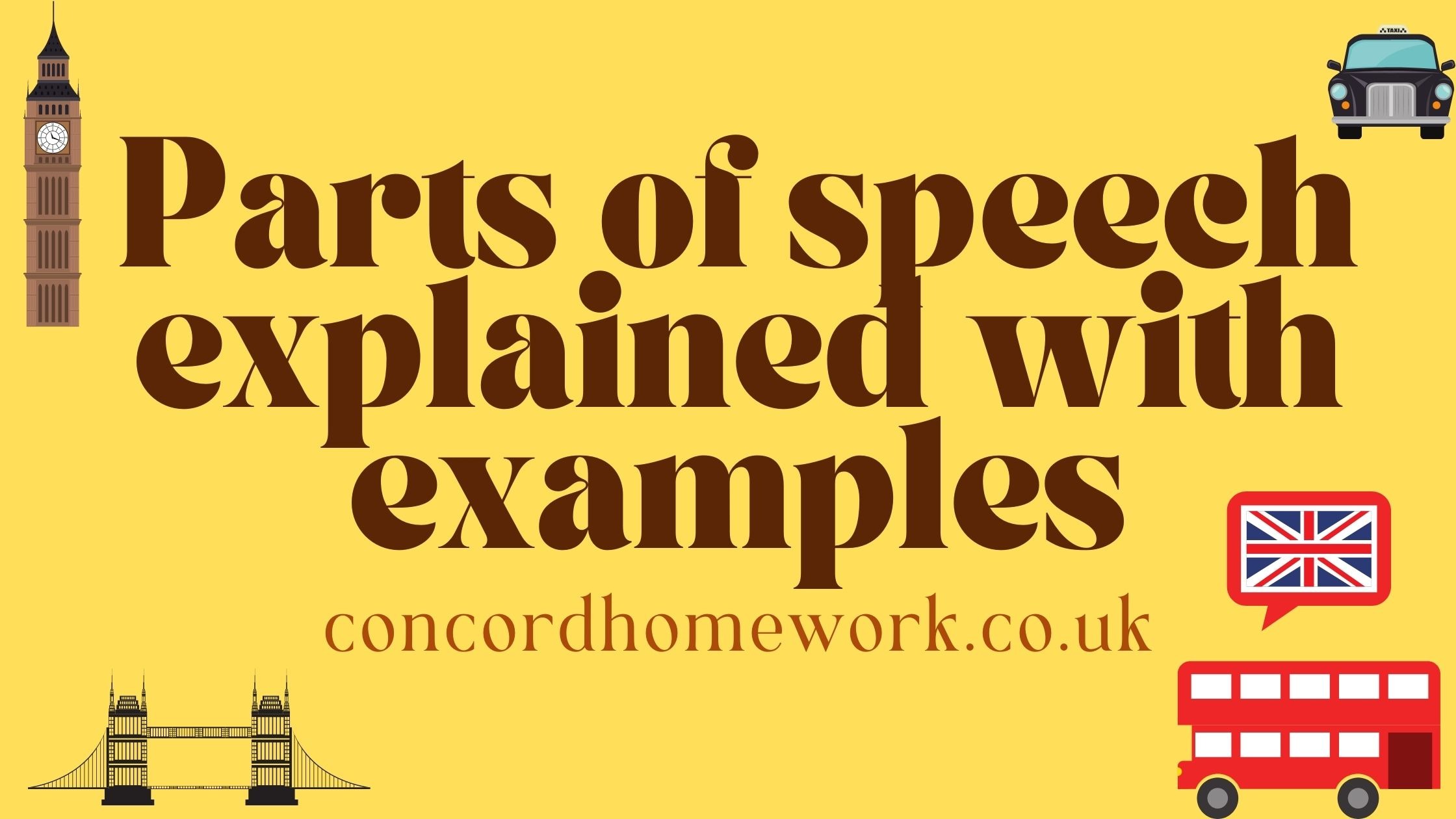Parts of Speech Explained with Examples
There are eight parts of speech in English language. They help you to understand and create good sentences.
1) Nouns
A noun is a naming word, from the Latin nomen (name).
It may name a specific person, creature, place or object (proper noun):
William Shakespeare, Spot, Edinburgh, the Independent.
It may name an individual belonging to a class of people, animals or things that can be directly seen, heard, touched or smelt (common noun):
doctor, rabbit, house, bicycle, water, squeak, stink.
It may be a quality, state of mind, attitude, idea or action that does not refer directly to the senses (abstract noun):
intelligence, sorrow, laziness, democracy, philosophy, violence.
It may refer to a group of individual people or animals (collective noun):
army, audience, chorus, flock, family, jury, majority, queue. Nouns are either singular – referring to one only: tree, woman, quality or plural – more than one: trees, women, qualities.
2) Pronouns
A pronoun stands in place of a noun: she, we, it, everybody.
Pronouns are a handy device for avoiding the repetition of nouns. Instead of writing:
The tree has been felled. The tree had been damaged in a storm, we are able to write:
The tree has been felled. It had been damaged in a storm.
Pronouns may be singular (I, he, she, it) or plural (we, they); the pronoun you may be singular or plural depending on whether it refers to one person or to several.
The most important categories of pronoun are:
personal e.g. I, me; you; he, she, it, him, her; we, us; they, them;
possessive e.g. mine, his, hers, yours;
demonstrative e.g. this, these, that, those (as in This belonged to my father);
interrogative e.g. who, whose, which, what (as in Who did that?);
indefinite e.g. anybody, none, no one, either, each;
relative e.g. who, whose, what, whom, that;
reflexive e.g. myself, ourselves, yourself, itself, himself.
3) Adjectives
An adjective is often said to describe a noun. In fact it modifies a noun, tells us something more precise about it, though many adjectives are, indeed, descriptive:
enthusiastic, tallest, invisible.
Others give different sorts of information:
eighth, many, those.
Adjectives are normally placed before the nouns they describe (jseveral large white whales) but other positions are possible:
The morning was misty and cold.
The morning, misty and cold, depressed his spirits.
If adjectives are formed from proper nouns they have capital letters (the American way of life, the Christian religion).
It is a particular flexibility of English that nouns are often used as adjectives (alarm clock, police van, chicken soup).
COMPARISON OF ADJECTIVES
When comparing only two persons or things, use the -er form of the adjective:
Simon is taller than his sister.
Which is newer, this one or that one?
When the adjective has no -er form, and in some cases to avoid clumsiness, use more:
That kitten is more active than this one.
His collection is more interesting than hers.
When comparing three or more, use the -est form:
Leroy is the tallest of the three.
The tiniest puppy is the prettiest.
When the adjective has no -est form, use most:
She is by far the most determined of all.
This is by far the most sensible of your proposals.
4) Verbs
A verb expresses an action or state of being: walk, made, fought, seems, existed.
He mended the puncture, smiled, mounted his bicycle and rode away.
We are very sad because they have suffered so much.
The garden had been neglected and the house was ruined.
In the first sentence, the four verbs are functioning on their own. In the other two examples, they need to be helped by the auxiliary verbs to be and to have in their various forms: have, had been and was.
5) Adverbs
Adverbs describe or enlarge the meaning of a verb, adjective or other adverb.
He called loudly.
There was a very faint reply.
He called more loudly.
When an adverb describes a verb, it usually indicates how, when, where or why the action of the verb is taking place.
Adverbs that indicate how are often formed from adjectives.
Usually one adds -ly: slow > slowly; strong >
Adjectives ending in -ue drop the -e: due > duly; true >
Adjectives ending in -y change to -ily: happy > happily; ready > readily; funny >
Adjectives ending in -// add -y: full > fully; shrill >
Adjectives ending in -ic usually add -ally: drastic > drastically; sarcastic > sarcastically (but note publicly).
Some adverbs have the same form as adjectives:
a long time (adjective), did you wait long} (adverb) a fast horse (adjective), the car went fast (adverb)
Some adverbs affect the whole sentence, not just the verb:
The book, then, makes an important contribution to our knowledge of food.
The adverb then has a dual purpose: it enlarges the meaning of the verb makes, and it also expresses a relationship between the whole sentence and what has gone before: in this case then expresses the conclusion. Other forms of relationships with what has gone before can also be expressed by adverbs, usually near the beginning of the sentence, e.g. however, nevertheless, incidentally, moreover, likewise, besides, therefore.
6) Prepositions
A preposition is a word that is placed before a noun or pronoun to link it to another part of the sentence or to the sentence as a whole. There are a large number of these, including: at, in, to, by, from, with, through, round:
On the beach Rakdeep gazed i the dolphin in amazement. You must walk round the wood, not through it.
Leon and Erica arrived during the afternoon, not after lunch as expected.
The preposition can affect the sense of some verbs, e.g. agree with! on! to:
We agree with you and with the action you have taken.
We agree on what we should do next.
Your brother will not agree to our suggestion.
The same word may be a preposition or an adverb:
Wait outside the door, (preposition)
Wait outside, (adverb)
Many sentences naturally end with a preposition:
What a mess your bedroom is in!
The husband was easy to talk to; the wife impossible to communicate with.
What did you mend it with? Where is she from?
Nowadays this is acceptable, although in the past it was absolutely forbidden and writers used to go to great lengths to avoid it. The so-called rule was famously ridiculed by Sir Winston Churchill (1874-1965) when he referred to ‘the sort of English up with which I will not put’ when more naturally he could have spoken of ‘the sort of English I will not put up with’.
On the other hand, a preposition at the end of a clause or sentence can sometimes sound awkward, especially in a more formal context:
This is the college I spent three happy years at.
This would be better reworded:
This is the college at which I spent three happy years.
7) Conjunctions
A conjunction connects two words or groups of words:
blue and white stripes; take it or leave it;
I went to bed early because I was tired.
It need not always be placed between the words being linked:
Because I was tired, I went to bed early.
Although he was injured, he went on playing.
It is possible for a word to be a conjunction in one sentence and have a different function in another:
Look before you leap, (conjunction)
It has happened before. (adverb)
We left before the end. (preposition)
8) Interjections or exclamations
An interjection or exclamation is a word or remark expressing emotion, usually sudden:
Aha! So it was you! You didn’t expect to be caught, eh? Ouch! That hurt!
Alas, it was the dog that died!
Bonus) Words with more than one function
English grammar is very flexible and there are many examples of words performing several functions. For example, the nouns dog, fcws, leg and school can all be used as verbs:
I’m going to leg it home.
It is sensible to bus the children to school.
The word down is a good example of a multi-function word:
Put it down (adverb)
Let’s walk down the hill, (preposition)
The pillows are filled with down. (noun)
A down payment of £10. (adjective)
The workforce decided to down tools, (verb)
“Thank you for taking the time to explore this topic with us! We hope you found the information helpful and insightful. Have any thoughts, questions, or additional examples to share? We’d love to hear from you in the comments below!
Don’t forget to spread the word by sharing this blog with your friends, family, and colleagues. Together, let’s continue to learn, grow, and connect with the world around us. Happy reading and sharing!”
Follow Me On TikTok:
Follow me!????????????????
Follow me on YouTube:
Subscribe!????????????????
What topics/worksheets do you need? Let me know in the comments below!




















